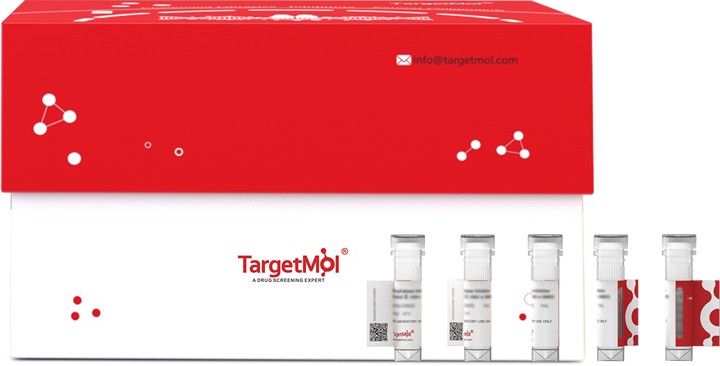
Protein structure of IL-15 (mouse):IL-15Ra (Sushi) (mouse):Fc (LALA-PG)-KIH (human) (rec.) (Prod. No. AG-40B-0257).IL-15 (mouse):IL-15Ra (Sushi) (mouse):Fc (LALA-PG)-KIH (human) (rec.) (#AG-40B-0257) increases proliferation of CTLL-2 mouse cytotoxic T cells.Method: Activity of IL-15 (mouse):IL-15Ra (Sushi) (mouse):Fc (LALA-PG)-KIH (human) (rec.) is measured using proliferation of CTLL-2 cells. CTLL-2 are grown in RPMI medium, glutamine, 10% FBS, 100 IU IL-2 (#AG-40B-0224) and different concentrations of IL-15 (mouse):IL-15Ra (Sushi) (mouse):Fc (LALA-PG)-KIH (human) (rec.) (#AG-40B-0257) or the control protein Fc (LALA-PG)-KIH (human) IgG1 Control (rec.) (#AG-35B-0018). Cell proliferation is quantified using PMS/MTS (CellTiter 96® AQueous One Solution Cell Proliferation Assay, Promega).
IL-15 (mouse):IL-15Ra (Sushi) (mouse):Fc (LALA-PG)-KIH (human) (rec.)
AG-40B-0257
Protein IDP48346
Product group Proteins / Signaling Molecules
Overview
- SupplierAdipoGen Life Sciences
- Product NameIL-15 (mouse):IL-15Ra (Sushi) (mouse):Fc (LALA-PG)-KIH (human) (rec.)
- Delivery Days Customer10
- CertificationResearch Use Only
- Concentration1 mg/ml
- Estimated Purity≥95%
- Protein IDP48346
- Protein NameInterleukin-15
- Scientific DescriptionInterleukin-15 (IL-15) is a cytokine that belongs to the interleukin-2 (IL-2) family and is essential for the development, proliferation and activation of immune cells, including natural killer (NK) cells, T cells and B cells. IL-15, unlike other cytokines, is widely expressed by many cell types including monocytes, macrophages, DC, fibroblasts, epithelial cells and skeletal muscle cells, but surprisingly not by T cells. IL-15 signals through a heterotrimeric receptor that is composed of the common gamma chain (gammac) subunit (CD132), the beta chain (betac) subunit (IL-2/IL-15R, CD122) and the IL-15 specific alpha subunit IL-15Ralpha (CD215). IL-15 binding to its trimeric receptor induces JAK1 activation which phosphorylates STAT3 via the beta chain, and JAK3 activation which phosphorylates STAT5 via the gamma chain. IL-15, like IL-2, stimulates the proliferation of T cells, induces the generation of cytotoxic lymphocytes and memory phenotype CD8 T cells, and stimulates the proliferation and maintenance of natural killer (NK) cells. In contrast to IL-2, IL-15 does not mediate activation-induced cell death (AICD) and does not consistently activate Tregs. If IL-2 is a promiscuously secreted molecule, IL-15 is locally secreted in small quantities where membrane-bound IL-15 induces signals at an immunological synapse. IL-15Ralpha (especially its sushi domain) acts more like a stabilizing and synergistic element (chaperone molecule) of IL-15, assisting IL-15 in its trans-presentation. The new recombinant protein IL-15 (mouse):IL-15Ra (Sushi) (mouse):Fc (LALA-PG)-KIH (human) (rec.) is an enhanced form of IL-15 with an extended half-life that stimulates the proliferation of T cells, B cells and NK cells in vivo, and increases its anti-tumor activity. The protein IL-15 (mouse):IL-15Ra (Sushi) (mouse):Fc (LALA-PG)-KIH (human) (rec.) is produced by using two different vectors, one encoding for the IL-15 (mouse):Fc (LALA-PG) Knobs sequence (synthesizing a protein of 50kDa) and one encoding for the IL-15Ra (Sushi) (mouse):Fc (LALA-PG) Holes sequence (synthesizing a protein of 40kDa). Both vectors transfected into HEK 293 cells produce both Fc molecules (Knobs-into-Holes technology; J.B. Ridgway, et al.; Protein Eng. 9, 617 (1996)) required for dimerization and for secretion of the final protein IL-15 (mouse):IL-15Ra (Sushi) (mouse):Fc (LALA-PG)-KIH (human) (rec.). The LALA-PG mutations inhibit binding to FcgammaRs and C1q while FcRn binding and Fc stability remain unaffected. InVivoKines™ are a new generation of recombinant fusion proteins for immunotherapeutic, preclinical and translational in vivo research, developed and manufactured by AdipoGen Life Sciences. - InVivoKines™. Recombinant Protein. IL-15 (aa 49-162) (mouse):Fc (LALA-PG) (human) Knobs and IL-15Ra (Sushi Domain) (aa 34-98) (mouse):Fc (LALA-PG) (human) Holes form the IL-15 (mouse):IL-15Ra (Sushi) (mouse):Fc (LALA-PG)-KIH (human) using the Knobs-into-Holes technology (see reference: J.B. Ridgway, et al.; Protein Eng. 9, 617 (1996)). Lyophilized. Contains PBS. Induces mouse CTLL2 (T cell line) proliferation with an ED50 of <300pM. Interleukin-15 (IL-15) is a cytokine that belongs to the interleukin-2 (IL-2) family and is essential for the development, proliferation and activation of immune cells, including natural killer (NK) cells, T cells and B cells. IL-15, unlike other cytokines, is widely expressed by many cell types including monocytes, macrophages, DC, fibroblasts, epithelial cells and skeletal muscle cells, but surprisingly not by T cells. IL-15 signals through a heterotrimeric receptor that is composed of the common gamma chain (gammac) subunit (CD132), the beta chain (betac) subunit (IL-2/IL-15R, CD122) and the IL-15 specific alpha subunit IL-15Ralpha (CD215). IL-15 binding to its trimeric receptor induces JAK1 activation which phosphorylates STAT3 via the beta chain, and JAK3 activation which phosphorylates STAT5 via the gamma chain. IL-15, like IL-2, stimulates the proliferation of T cells, induces the generation of cytotoxic lymphocytes and memory phenotype CD8 T cells, and stimulates the proliferation and maintenance of natural killer (NK) cells. In contrast to IL-2, IL-15 does not mediate activation-induced cell death (AICD) and does not consistently activate Tregs. If IL-2 is a promiscuously secreted molecule, IL-15 is locally secreted in small quantities where membrane-bound IL-15 induces signals at an immunological synapse. IL-15Ralpha (especially its sushi domain) acts more like a stabilizing and synergistic element (chaperone molecule) of IL-15, assisting IL-15 in its trans-presentation. The new recombinant protein IL-15 (mouse):IL-15Ra (Sushi) (mouse):Fc (LALA-PG)-KIH (human) (rec.) is an enhanced form of IL-15 with an extended half-life that stimulates the proliferation of T cells, B cells and NK cells in vivo, and increases its anti-tumor activity. The protein IL-15 (mouse):IL-15Ra (Sushi) (mouse):Fc (LALA-PG)-KIH (human) (rec.) is produced by using two different vectors, one encoding for the IL-15 (mouse):Fc (LALA-PG) Knobs sequence (synthesizing a protein of 50kDa) and one encoding for the IL-15Ra (Sushi) (mouse):Fc (LALA-PG) Holes sequence (synthesizing a protein of 40kDa). Both vectors transfected into HEK 293 cells produce both Fc molecules (Knobs-into-Holes technology; J.B. Ridgway, et al.; Protein Eng. 9, 617 (1996)) required for dimerization and for secretion of the final protein IL-15 (mouse):IL-15Ra (Sushi) (mouse):Fc (LALA-PG)-KIH (human) (rec.). The LALA-PG mutations inhibit binding to FcgammaRs and C1q while FcRn binding and Fc stability remain unaffected. InVivoKines™ are a new generation of recombinant fusion proteins for immunotherapeutic, preclinical and translational in vivo research, developed and manufactured by AdipoGen Life Sciences.
- Storage Instruction-20°C,2°C to 8°C
- UNSPSC12352202


